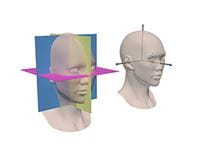Physical Examination

In this section, the authors present a problem-focused physical examination aimed at evaluating jaw deformities. The examination is divided into two parts: an assessment of facial form and a cursory evaluation. The purpose of the first is to determine the presence, extent, and severity of a deformity; the second seeks to identify signs of disease. The assessment of facial form includes evaluations of facial soft-tissue and dentition. The goal is to diagnose a jaw deformity; however, as the skeleton cannot be inspected, one infers bone deformity by appraising facial appearance and dentition.
During the physical examination, the examiner must determine the size, position, orientation, shape, and symmetry of the jaws. Assessing three of these properties—position, orientation, and symmetry—requires a frame of reference, the most useful of which is that defined by the standard anatomical planes: median, coronal, and axial.6, 7, 10 The median plane (i.e., the plane of symmetry of the face) divides the face into right and left halves; the coronal plane divides the face into anterior and posterior portions; and the axial plane divides the face into upper and lower segments. These planes are mutually perpendicular, or orthogonal. The lines of intersection between the planes form the axes of the face. The intersection of the medial and axial planes forms the anteroposterior axis, the intersection of the medial and coronal planes forms the vertical axis, and the intersection of the axial and coronal planes forms the transverse axis. These axes define the cardinal directions of the face: front, back, cranial, caudal, right, and left (Figure 3).
Throughout the physical examination, the planes of our reference system (i.e., median, axial, and coronal) are imaginary. We mentally construct them, while observing the patient in a standard reference posture.
The standard reference posture of the head is the natural head posture (NHP).10-12 The NHP is a component of standard international anatomical alignment, a reference position in which a subject is standing erect, feet together, and hands to the side, with the face looking forward toward the horizon. In this posture the head is not flexed or extended, nor is it rotated or tilted.
Table of Contents


